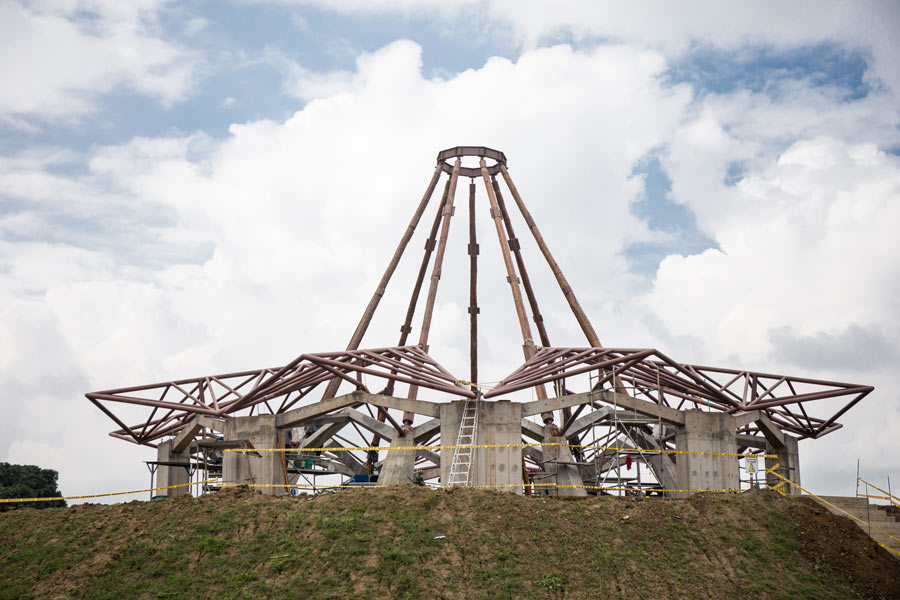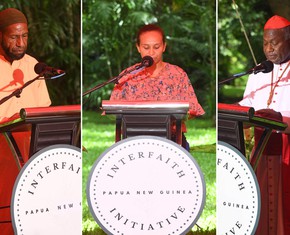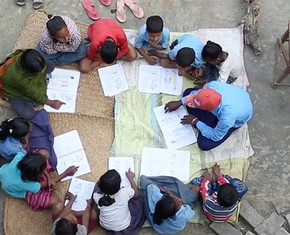The local Baha’i House of Worship in Norte del Cauca is rising out of the land, clearly visible to the village that has been awaiting its arrival.
Christina Mosquera’s daily bus route from Santander de Quilichao to Puerto Tejada passes through Agua Azul and by the Temple site. Often she hears the route’s travelers, many from neighboring villages, wondering about the edifice under construction. “They ask whether it is a hospital, a recreation center, or a school,” said Ms. Mosquera, a Baha’i from the region who has been involved with the work of the reforestation project on the Temple land.
The heightened awareness is connected to recent significant progress on the construction of the House of Worship. The structure has become much more visible to those passing on the road below the Temple site, on foot, by bus, or otherwise. The Temple’s central edifice is now a tangible form—the concrete structure has been completed and nine timber masts have been raised. The masts form the inner dome of the House of Worship and are crowned by a steel ring-beam in which the Greatest Name (the Baha’i symbol for the word Baha, or glory, contained in the name of the founder of the Baha’i Faith, Baha’u’llah) will be encased.
Every day through the window of the bus, Ms. Mosquera has watched the Temple’s construction advance since it began in January. In light of the burgeoning curiosity about the structure, she arranged with her bus drivers to be able to share information about the Temple with fellow passengers. The bus often slows down while passing the property so she has time to speak about the House of Worship.

The nine timber masts that form the inner dome of the House of Worship are crowned by a steel ring-beam which will encase the Greatest Name once the Temple is completed.
“I tell them that the House of Worship is being built there—a center for all the souls to connect with God, to connect with the creator,” said Ms. Mosquera. “People ask if everyone can really come to the House of Worship, and I tell them yes, everyone can come and pray.”
Briefly, the original purpose of temples and houses of worship is simply that of unity—places of meeting where various peoples, different races and souls of every capacity may come together in order that love and agreement should be manifest between them. That is why Baha’u’llah has commanded that a place of worship be built for all the religionists of the world; that all religions, races and sects may come together within its universal shelter; that the proclamation of the oneness of mankind shall go forth from its open courts of holiness—the announcement that humanity is the servant of God and that all are submerged in the ocean of His mercy. – Abdu’l-Baha, The Promulgation of Universal Peace, p. 65.
Bonds of unity and cooperation have been strengthened in Norte del Cauca through the processes set in motion by the Temple project and the dynamic community-building activities in surrounding villages and towns. During the recent celebrations for the bicentenary of the birth of Baha’u’llah, the village’s numerous festivities attracted hundreds to activities ranging from acts of service, such as planting 200 trees, to invitations for community prayer and worship.

Some of the volunteers who have worked at the bosque nativo (native forest)
A Baha’i House of Worship expresses the coherence between the natural environment of the region and the life of the community. This relationship is symbolized most visibly through the Temple’s design, which was inspired by the cocoa pod, a plant that grows abundantly in Colombia. Yet many aspects of the Temple project strive to evince this unity through their systems—efforts have been made for the House of Worship and its auxiliary structures, for example, to receive between 70 to 100 percent of their power from solar panel systems.
On the land where the House of Worship sits is a forest where the community has been undertaking an initiative to reintroduce native vegetation to the area. The natural flora had been previously decimated by years of monoculture plantations, but in the five years since the reforestation project has begun, a number of plants have been recovered, some which had been thought to be almost entirely lost to the northern region of Colombia.
“The Temple is a unique project,” said journalist Raúl Chará at a recent press conference. “At a time of so many crises in the region and in the world, the Baha’i House of Worship stands apart for its potential for social good.”
















Comments
Sign in or create an account
Continue with Googleor